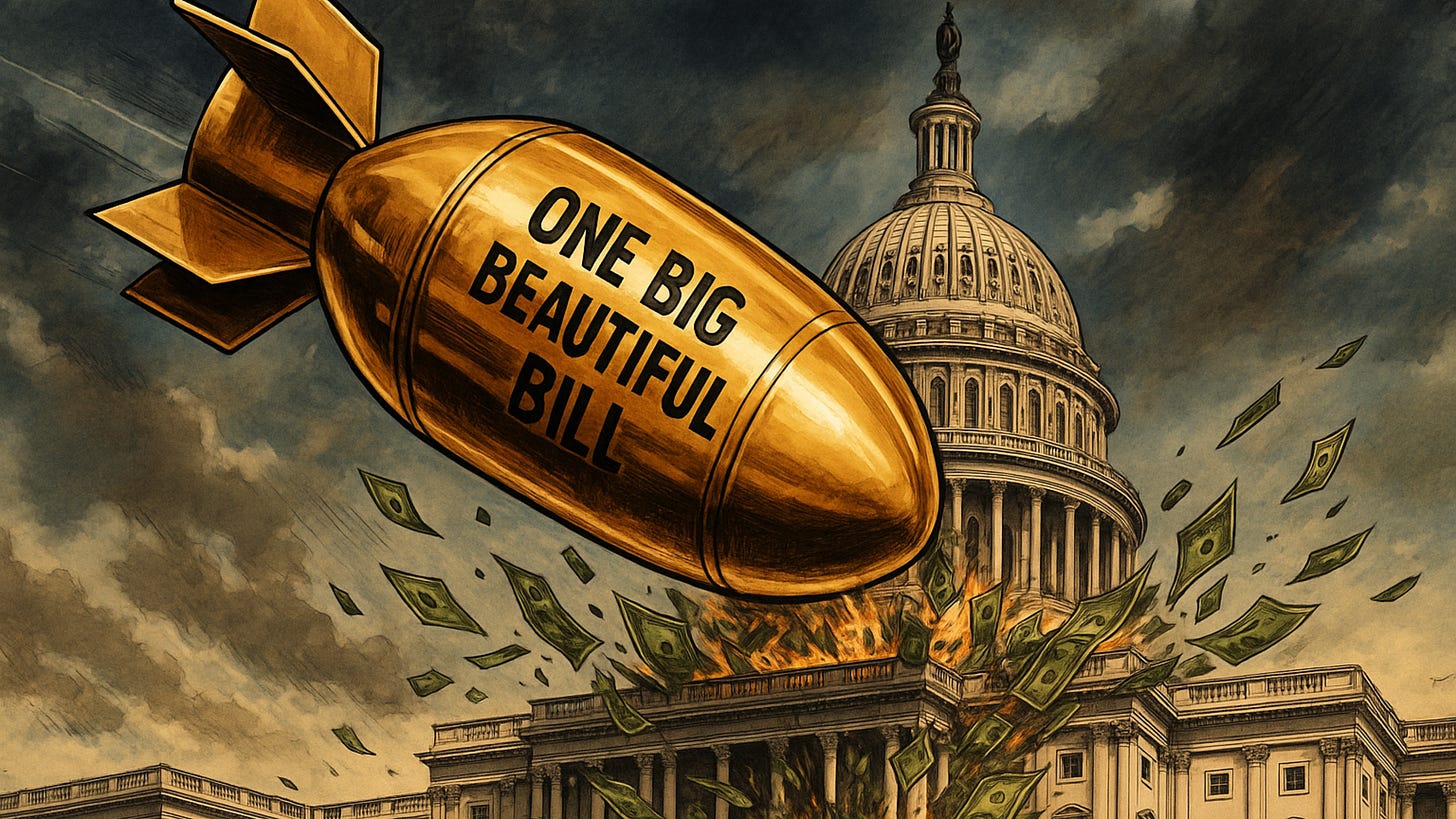One Big, Beautiful Implosion
How Trump’s flagship budget collapsed under the weight of its own contradictions.
The Trump administration’s budget agenda—boastfully titled the One Big Beautiful Bill Act—has just suffered a stunning rebuke from within. Not by Democrats, not by protests, not by courts. But by Republicans themselves. In a 21–16 vote, the House Budget Committee torpedoed the legislation, delivering a rare and resounding rejection of a sitting president’s top fiscal priority by his own party.
The bill was designed as a crown jewel of Trump’s second-term agenda: tax cuts now, spending cuts later, and a glossy fulfillment of campaign promises meant to gild his legacy and neuter federal entitlements in one masterstroke. But when it came time to vote, five Republican members—Reps. Chip Roy, Ralph Norman, Josh Brecheen, Andrew Clyde, and Lloyd Smucker—crossed the aisle to join Democrats in saying no. Not because the bill cut too much. But because it didn’t cut enough.
Yes, the legislation slashed over $700 billion from Medicaid. Yes, it sought to impose work requirements and strip coverage from undocumented immigrants. But the hardliners were unmoved. They didn’t want delayed pain—they wanted blood now. Some members of the Freedom Caucus didn’t just oppose the bill—they ridiculed it. House Freedom Caucus Chair Andy Harris called the Medicaid provisions a farce:
“The common-sense work requirement for able-bodied adults doesn’t start for four years (into the next administration) and CAN BE WAIVED by any state for ‘hardship’ that they determine (and they will). What a joke.”
For hardliners, the problem wasn’t the knife—it was that it was sheathed.
They wanted work requirements implemented by 2026, not 2029. They demanded immediate eligibility crackdowns and an end to state-level discretion. In their view, Trump’s bill offered austerity on layaway—and that wasn’t enough.
Fiscal hawks were similarly appalled by the bill’s arithmetic. The Committee for a Responsible Federal Budget projected it would balloon the national debt by $3.3 trillion over the next decade. Trump’s allies had stuffed the legislation with front-loaded tax breaks—red meat for the base—while promising spending cuts that wouldn’t materialize until long after the ink dried. It was fake fiscal discipline—a golden toilet bowl full of IOUs, dressed up as reform and leaking red ink by design.
Meanwhile, Republican moderates balked at other poison pills. The cap on state and local tax (SALT) deductions—raised modestly to $30,000 for families under $400,000—still wasn’t enough for lawmakers from high-tax states like New York and California. Their constituents, already strained by inflation and property tax hikes, would see little relief. Yet any attempt to raise the SALT cap further was met with cries from the right for deeper entitlement cuts to offset the costs.
In short: the party’s ideological tectonics finally snapped. Trump’s gilded vision—slashing Medicaid, gutting green energy credits, handing billions to the ultra-rich, and selling it all as populism—couldn’t hold together under the weight of its own contradictions. The MAGA machine wanted austerity and largesse at once. Fiscal conservatives demanded real math. Moderates asked for political oxygen. No one got what they wanted.
And then the vote failed.
Trump, predictably, lashed out. He raged against the “grandstanders” who defied him, calling for unity even as his own coalition disintegrated on live television. House Speaker Mike Johnson offered a brittle smile and a few vague promises to rework the bill. Negotiations, we’re told, are ongoing. The show must go on. But the illusion is cracked.
This wasn’t just a procedural hiccup. It was a high-definition display of Republican dysfunction in the Trump era. The Freedom Caucus wants the safety net incinerated. The moderates want to survive re-election. Trump wants a legacy etched in tax cuts and cultural warfare. And now, for the first time in this term, the math is catching up to the myth.
The irony, of course, is lethal. The bill’s Medicaid cuts—if enacted—could have stripped health coverage from over 7.6 million Americans. The very districts whose representatives voted for Trump in droves would be hit hardest. Rural hospitals, children’s clinics, elderly care networks—every one of them on the chopping block in the name of “fiscal discipline” that somehow also included corporate windfalls and luxury tax loopholes.
In its place, we now have an ideological standoff. Hardline conservatives are drafting alternate proposals with deeper cuts. Moderates are quietly floating concessions in hopes of salvaging a deal. Trump is seething. The Capitol is on hold.
One big, beautiful implosion.






